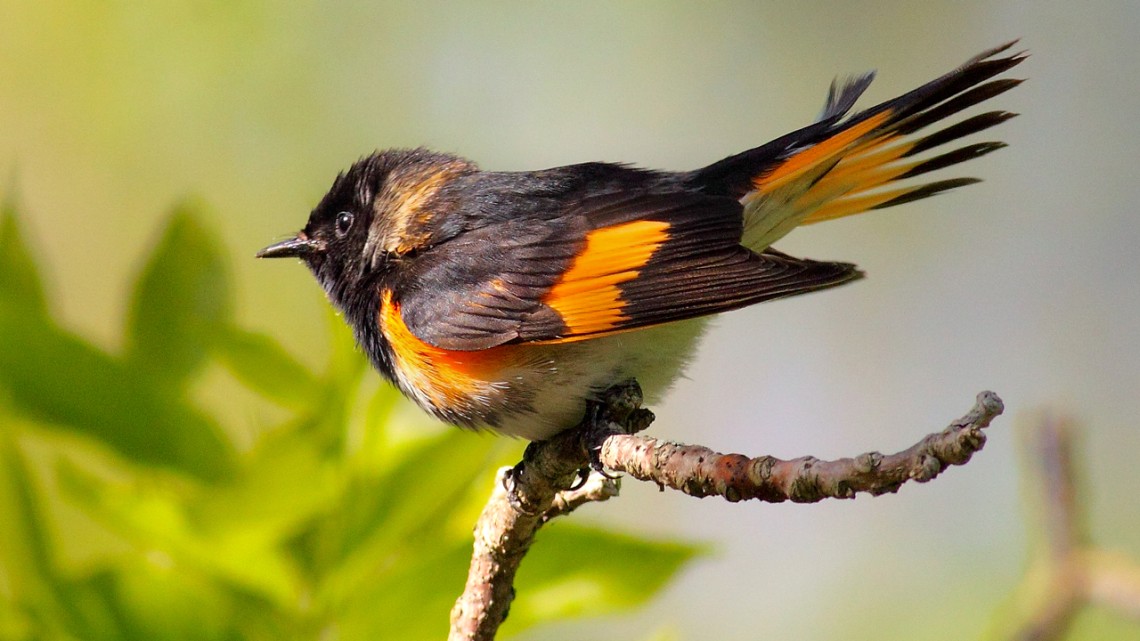
An American redstart.
Risky strategy helps migratory birds offset climate change
By Pat Leonard
Deteriorating habitat conditions caused by climate change are wreaking havoc with the timing of bird migration. A new study demonstrates that birds can partially compensate for these changes by delaying the start of spring migration and completing the journey faster – but the strategy comes with a decline in overall survival.
“We found that our study species, the American redstart, can migrate up to 43% faster to reach its breeding grounds after delaying departure from wintering grounds in Jamaica by as much as 10 days,” said Bryant Dossman, Ph.D. ’21, lead author of “Migratory Birds With Delayed Spring Departure Migrate Faster But Pay the Costs,” published in the journal Ecology.
“But increased migration speed also led to a drop of more than 6% in their overall survival rate,” said Dossman, who led the study while at Cornell and is currently a postdoctoral fellow at Georgetown University.
Tactics for speeding up migration can include flying faster and making fewer or shorter stopovers to refuel along the way. Though migrating faster helps compensate for delayed departures, it can’t entirely make up for lost time. In general, for a 10-day delay, Dossman says individuals can recover about 60% of the lost time, but that means still arriving late on the breeding grounds.
Jamaica has become increasingly dry in recent decades and that translates into fewer insects, the mainstay of the redstart diet. Now, it takes the birds longer to get into condition for the rigors of migration, especially from poorer quality habitats. At the same time, plants are greening and insects are coming out sooner on the breeding grounds – also because of climate change.
“On average, migratory songbirds only live a year or two, so keeping to a tight schedule is vital. They’re only going to get one or, at most, two chances to breed,” said Dossman.
The study is based on 33 years of American redstart migration departure data at the Fort Hill Nature Preserve in Jamaica. The study site is overseen by senior co-author Peter Marra, director of the Earth Commons – Georgetown University’s Institute for Environment & Sustainability. Using this historical data in tandem with automated radio tracking and light-level tags, scientists compared the redstarts’ expected departure date with their actual departure date in recent years to see how it’s changed.
“The behavioral shifts documented in this research remind us that the manner in which climate change affects animals can be subtle and, in some cases, able to be detected only after long term study,” said Amanda Rodewald, the Garvin Professor and Senior Director of the Center for Avian Population Studies at the Cornell Lab of Ornithology and a co-author on the paper.
“Understanding how animals can compensate is an important part of understanding where the impacts of climate change will play out,” Marra said. “In this case, we may not lose a species entirely, but it is possible that populations of some species may go extinct locally due to climate change.”
What happens on the redstart wintering grounds carries over into the breeding season. Though the redstart population is stable and increasing in much of its breeding range, detailed eBird Trend maps show the species is declining in the northeastern United States and southern Quebec, Canada.
“The good news is that birds are able to respond to changes in their environment,” Dossman said. “They have some flexibility and variation in their behaviors to begin with, but the question is, have they reach the limit of their ability to respond to climate change?”
Colin Studds of the University of Maryland co-authored the paper. Research funding was provided by the Cornell Lab of Ornithology, the Smithsonian Institute and the National Science Foundation.
Pat Leonard is a writer for the Cornell Lab of Ornithology.
Media Contact
Get Cornell news delivered right to your inbox.
Subscribe
